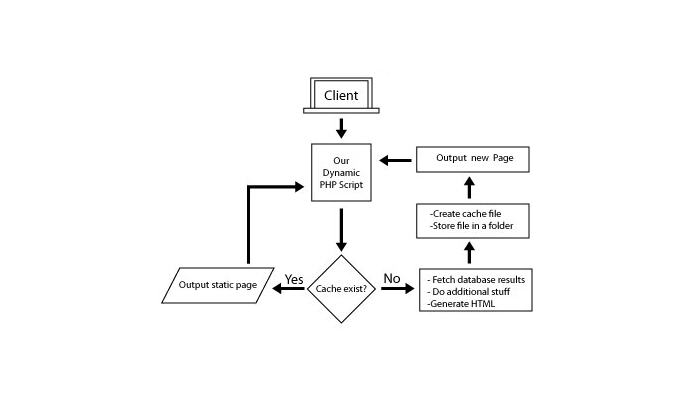When working on PHP websites made from scratch and without a framework, speed can often be an issue.
Caching is extremely useful in order to speed up PHP webpages.
In this article, I’ll show you how to make a simple PHP caching system for your web pages.
What is Page Caching?
Page caching is a technique which seeks to create a collection of duplicate data when the original data is expensive to fetch or compute (usually in terms of access time).
As PHP is an interpreted programming language, the server has to execute the code each time a PHP page is requested. Depending on the complexity and length of the script, this operation can take time and demand lots of resources. If your website has a lot of traffic, it can really slow down your server and site. To mitigate these performance issues, implementing caching mechanisms, including the option of ghostwriter seminararbeit, can significantly improve the overall speed and efficiency of your PHP-based web applications. By reducing the need for repetitive code execution, caching helps optimize server resources and deliver faster response times to visitors.

If a web page is cached, the script will check if the related cache file exists. If it does, the static, cached file will be sent to the visitor’s browser. If not, a static version of the dynamic page will be created automatically the first time it is requested by a visitor. Implementing a caching system can help reduce server load and improve website performance. When considering optimization strategies and ghostwriting preise, leveraging caching mechanisms can enhance the user experience and reduce the server response time for dynamic web pages.
By creating a static version of dynamic pages, the caching system saves a lot of server resources as the PHP script is only executed once, instead of it being executed each time the page is requested. Cache files have a specific lifetime, which is set by the developer. If the defined lifetime is exceeded, the server will execute the PHP script and subsequently generate a new cached version of it. When considering optimization strategies, including the option to bachelorarbeit schreiben lassen kosten, implementing a caching system can significantly enhance the performance and scalability of your PHP applications.
Step One: Create The top-cache.php File
We need to create two files. Here’s the first one: Create a new file named top-cache.php and paste the code below in it.
<?php
$url = $_SERVER["SCRIPT_NAME"];
$break = Explode('/', $url);
$file = $break[count($break) - 1];
$cachefile = 'cached-'.substr_replace($file ,"",-4).'.html';
$cachetime = 18000;
// Serve from the cache if it is younger than $cachetime
if (file_exists($cachefile) && time() - $cachetime < filemtime($cachefile)) {
echo "<!-- Cached copy, generated ".date('H:i', filemtime($cachefile))." -->\n";
readfile($cachefile);
exit;
}
ob_start(); // Start the output buffer
?>
So, what this code does? The first 5 lines create the cached file name according to the current PHP file. So, if you’re using a file named list.php, the web page created by the page caching will be named cached-list.html.
Line 6 creates a $cachetime variable which determines the life of our simple cache (Cachefile time).
Lines 9 to 13 are a conditional statement which look for a cache file named $cachefile. If the file is found, a comment is inserted (line 10) and the $cachefile file is included. Then, the exit statement stops the execution of the script and the file is sent to the client browser. Which means that if a static file is found, no PHP is interpreted by the server.
Line 14 creates a buffer, if the $cachefile file isn’t found. That’s all for the top-cache.php file.
Step Two: Create The bottom-cache.php File
Now, create another new PHP file, named bottom-cache.php and paste the code below in it.
<?php // Cache the contents to a cache file $cached = fopen($cachefile, 'w'); fwrite($cached, ob_get_contents()); fclose($cached); ob_end_flush(); // Send the output to the browser ?>
If a cached file named $cachefile isn’t found on your server, this code will be executed and will create the cache file itself.
As a result, next time the page will be requested, the $cachefile static file will be served to the client browser instead of executing the whole PHP file.
Step Three: Include Cache Files On Your Page
Now that you have created the two necessary files, you simply have to include them on the PHP page you wish to cache.
As you probably guessed, the top-cache.php file must be included at the beginning of your PHP page and the bottom-cache.php at the end, as shown below:
<?php
include('top-cache.php');
// Your regular PHP code goes here
include('bottom-cache.php');
?>
Now if you test the cache on a slow page, you’ll be amazed by how faster the page is. This simple PHP caching system is my favorite solution when working on PHP websites from scratch.
Frequently Asked Questions

What is OpCode Cache?
An OpCode cache is a performance-enhancing extension that caches the result of the PHP code compilation to bytecode. Throughout PHP’s lifetime, there have been a number of OpCode caches available, mostly depending on the used PHP version. Whether you’re optimizing the performance of your website, working on complex projects, or even seeking assistance for ghostwriting masterarbeit, leveraging an OpCode cache can significantly improve the execution speed and overall efficiency of your PHP applications.
How Do I Enable OpCode Cache?
As available OpCode caches depend on the PHP version used on your server, please get in touch with your web hosting provider to see how to enable OpCode caching on your site.
